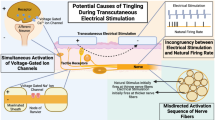Abstract
We proposed a transcutaneous electrical stimulation method to elicit pressure and vibration at any intended intensity and/or frequency. First, pressure and vibration were induced via a series of rectangular pulse trains delivered to the surface electrodes placed on the index finger pad of 46 healthy subjects in total. Load cells and coin motors were employed to quantify the perception intensity and frequency of the elicited sensations. We observed that the perception intensity and frequency were almost linearly correlated with the stimulation intensity and frequency, respectively, with the correlation coefficients larger than 0.96. The strong consistency of the sensation quality within an individual enabled us to find the stimulus parameters, the pulse amplitude and frequency, for a given (desired) intensity and frequency of pressure and vibration. Finally, experiments were conducted to give reliability to the proposed method by applying the estimated pulse parameters; the errors between the intended intensity/frequency and the perception intensity/ frequency were less than 5%. The results suggested that the proposed method can be employed to collect and process the tactile sensor information, and then cause the user to ‘feel’ the same sensation via appropriate transcutaneous electrical stimulation.
Similar content being viewed by others
References
Cordon, S. M. G., Hwang, S. H., Song, T., and Khang, G., “Current and Frequency Modulation for the Characterization of Electrically-Elicited Tactile Sensations,” International Journal of Precision Engineering and Manufacturing, Vol. 13, No. 11, pp. 2051–2058, 2012.
Ara, J., Hwang, S. H., Song, T., and Khang, G., “Electrically-Elicited Tactile Sensation for Different Modulation Types, Polarities and Waveforms of Stimulation Pulse Trains,” International Journal of Precision Engineering and Manufacturing, Vol. 13, No. 10, pp. 1911–1916, 2012.
Ara, J., Hwang, S. H., Song, T., and Khang, G., “Effects of the Stimulus Parameters on the Tactile Sensations Elicited by Single-Channel Transcutaneous Electrical Stimulation,” International Journal of Precision Engineering and Manufacturing, Vol. 15, No. 2, pp. 305–313, 2014.
Lee, S., Choi, Y., Ma, J., and Khang, G., “A Feasibility Study of Communication Utilizing Electrically-Elicited Tactile Sensations,” Proc. of the 52th Korean Society of Medical & Biological Engineering, pp. 538–540, 2017.
An, B., Ma, J., Hwang, S. H., Song, T., and Khang, G., “Adaptation of Sensory Nerve Afferents for Selective Elicitation of Tactile Sensations,” Journal of the Korean Society for Precision Engineering, Vol. 32, No. 10, pp. 845–850, 2015.
Kajimoto, H., Kawakami, N., and Tachi, S., “Optimal Design Method for Selective Nerve Stimulation and Its Application to Electrocutaneous Display,” Proc. of 10th Symposium on Haptic Interfaces for Virtual Environment and Teleoperator Systems, pp. 303–310, 2002.
Kajimoto, H., Kawakami, N., Maeda, T., and Tachi, S., “Electrocutaneous Display with Receptor Selective Stimulations,” Electronics and Communications in Japan (Part II: Electronics), Vol. 85, No. 6, pp. 40–49, 2002.
Ochoa, J. and Torebjörk, E., “Sensations Evoked by Intraneural Microstimulation of Single Mechanoreceptor Units Innervating the Human Hand,” The Journal of Physiology, Vol. 342, No. 1, pp. 633–654, 1983.
Suzuki, T., Mabuchi, K., Kunimoto, M., Shimojo, M., Saito, T., et al., “Relationship between Intraneural Electrical Stimulation and Evoked Pressure Sensation-Psychophysical Quantification,” Proc. of the 5th Annual Conference of the IFESS, pp. 407–409, 2000.
Shimojo, M., Suzuki, T., Namiki, A., Saito, T., Kunimoto, M., et al., “Development of a System for Experiencing Tactile Sensation from a Robot Hand by Electrically Stimulating Sensory Nerve Fiber,” Proc. of IEEE International Conference on Robotics and Automation, pp. 1264–1270, 2003.
Cipriani, C., D’Alonzo, M., and Carrozza, M. C., “A Miniature Vibrotactile Sensory Substitution Device for Multifingered Hand Prosthetics,” IEEE Transactions on Biomedical Engineering, Vol. 59, No. 2, pp. 400–408, 2012.
Ryu, J., Lee, C.-W., and Choi, S., “Improving Vibrotactile Pattern Identification for Mobile Devices Using Perceptually Transparent Rendering,” Proc. of the 12th International Conference on Human Computer Interaction with Mobile Devices and Services, pp. 257–260, 2010.
Hwang, I., Seo, J., Kim, M., and Choi, S., “Vibrotactile Perceived Intensity for Mobile Devices as a Function of Direction, Amplitude, and Frequency,” IEEE Transactions on Haptics, Vol. 6, No. 3, pp. 352–362, 2013.
Maeno, T., Otokawa, K., and Konyo, M., “4A-5 Tactile Display of Surface Texture by Use of Amplitude Modulation of Ultrasonic Vibration,” Proc. of IEEE Ultrasonics Symposium, pp. 62–65, 2006.
Makino, Y. and Shinoda, H., “Selective Stimulation to Superficial Mechanoreceptors by Temporal Control of Suction Pressure,” Proc. of First Joint Eurohaptics Conference and Symposium on Haptic Interfaces for Virtual Environment and Teleoperator Systems, pp. 229–234, 2005.
Author information
Authors and Affiliations
Corresponding author
Rights and permissions
About this article
Cite this article
Ma, J., Khang, G. Quantification and Adjustment of Pressure and Vibration Elicited by Transcutaneous Electrical Stimulation. Int. J. Precis. Eng. Manuf. 19, 1233–1238 (2018). https://doi.org/10.1007/s12541-018-0145-5
Received:
Revised:
Accepted:
Published:
Issue Date:
DOI: https://doi.org/10.1007/s12541-018-0145-5




